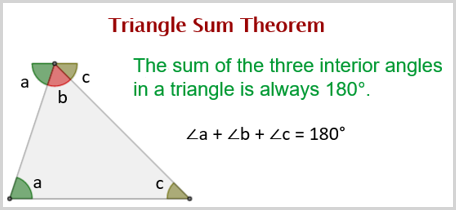
TRIANGLES (Triangle Sum Theorem)
 |
Unit Overview
In this unit, students will learn and be able to apply the Triangle Sum Theorem.
Key Vocabulary

Triangle Sum Theorem
In a triangle, the three interior angles always add to 180°.
x + y + z = 180°
Example A: Find the missing “x.”
 |
a.) Start: x + y + z = 180°
b.) Fill in what we know: x + 32° + 24° = 180°
c.) Add interior angles: x + 56° = 180°
d.) Calculate for x: x = 180° − 56°x = 124°
Example B: Solve for x.
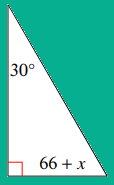
a.) Start: x + y + z = 180°
b.) Fill in what we know: 30° + 90° + 66 + x = 180°
c.) Add interior angles: 186° + x = 180°
d.) Calculate: x = 180° − 186° x = -6
REMEMBER: ALL THREE INTERIOR ANGLES OF A TRIANGLE MUST ADD TO 180°
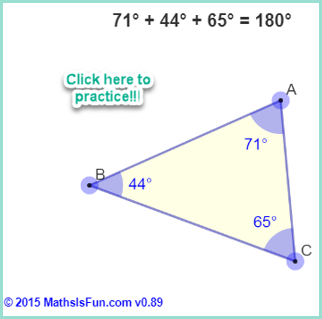 |
Let'ts Practice
1.) Find the Missing Angle “C.”
|
2.) Find the Missing Angle “C”
|
Equilateral, Isosceles and Scalene
These are three special names given to triangles that tell how many side and angles are equal. Triangles are polygons that have three sides, three vertices, and three angles. One way to classify triangles is by the length of their sides.
| Equilateral Triangles An equilateral triangle has all three sides equal in length. Its three angles are also equal, and they are each 60°. |
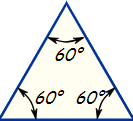 |
Isosceles Triangles An isosceles triangle has two sides of equal length. The angles opposite the equal sides are also equal. |
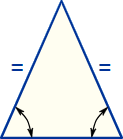 |
Scalene Triangles A scalene triangle has no sides of equal length. Its angles are also all different in size. The shortest side would be opposite the smallest angle. The longest side will be the biggest angle. |
 |
Let's Practice
3.) Name the type of triangle below.
|
| |
4.) Find the value of angle “x” for the following triangle:
|
|
6.) Find the value of angle “x” for the following triangle:
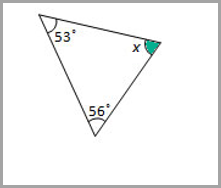 |
Summary of Triangle Sum Theorem
 |
Let’s Practice
7.) What is the size of the missing angle “B?”
|
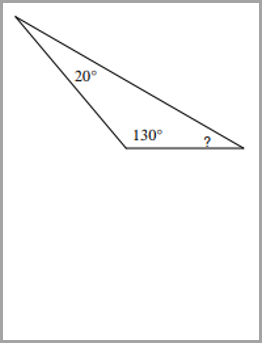 |
9.) What is the size of the missing angle “?”
|
10.) What is the size of the missing angle “x?”
|